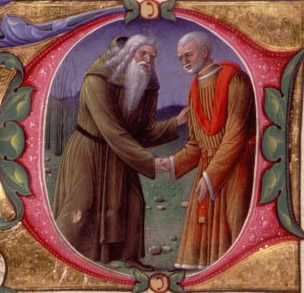A series of different factors contributed to creating the legend of Arnau de Vilanova as an expert in the occult arts. The apocalyptic prophetism of some of his spiritual works played a key part in this, as did his religious heterodoxy in general, which led to conflicts with the Inquisition during his lifetime and the posthumous condemnation of his spiritual works. Another cause was his interest in the medical applications of astrology and natural magic.
The myth of Arnau, like all myths, was gradually forged in a complex process: it began in the 14th century and reached its peak in the 16th century. Throughout the 300 years during which the Arnaldian legend was being developed, we can distinguish three basic traditions linked to the occult arts: the one linked to necromancy, the one linked to alchemy and the one derived from eschatological prophetism. What is more, the image of an empirical physician was also transmitted, which is quite far from the Galenism he professed.

Arnau the necromancer
Among the calumnies that circulated about Arnau in his lifetime, as he himself condemned in his Raonament d’Avinyó (1310) one was that he was a necromancer and sorcerer. Therefore, the myth of Arnau as a master of the occult arts seems to be rooted in the image of Arnau which came from the contemporary detractors of his religious opinions. This fame must have contributed to the suspicions of Arnau’s complicity with the presumed poisoning of Pope Benedict XI by the Franciscan Bernat Deliciós (Bernard Délicieux), as reflected in the transcript of the trial against him (1319). In reality, all of these suspicions were unfounded, given that the pope died of natural causes in 1304.
Arnau the alchemist
His fame as an alchemist, through which he came to be considered one of the prime authors of mediaeval alchemy with an extensive alchemical corpus attributed to him, came quite early. We can highlight the following milestones:
- In the mid-14th century, the canonist Giovanni d’Andrea stated that Arnau had managed to manufacture gold wands.
- In the late 14th century, Arnau appeared as the prototype of an alchemist in one of Chaucer’s Canterbury Tales de Chaucer.
- Legend has it that Raimon Llull, who was also falsely attributed an alchemical corpus, had been converted to the truth of alchemy after meeting Arnau.
- In addition to manufacturing gold, Arnau’s other legendary great alchemical feat was to create an artificial man or homunculus. The theologian Alonso de Madrigal, el Tostado (1400 1455), recounts the episode in which Arnau created an artificial human being in a vessel but did not dare to bring the creation to its final fruition for fear of being seen as a usurper of God’s power.
Arnau the prophet
Without a doubt, the part of Arnau’s spiritual works that left the most lasting memory were his apocalyptic prophesies because of the scandal they unleashed and because they were easy to ridicule. And yet their main message has been forgotten: the need to reform the Church. This distortion reached its peak in around 1500 when Giovanni Pico della Mirandola, and with him Symphorien Champier, scoffed at Arnau for having predicted the arrival of the Antichrist and the end of the world which did not come, groundlessly attributing an astrological base to Arnau’s prophetism.
Arnau the magician
All of the traditions converged in the Renaissance in an archetypal image of Arnau as the physician-magician who had mastered a wide variety of knowledge – medicine, theology, philosophy, astrology, magic and alchemy – and languages – Latin, Greek, Arabic and Hebrew – not only because a figure like that fit the neo-Platonic idea of complete knowledge but also because the printing press’s ability to spread information more easily provided access to the texts that transmitted the different traditions and the Arnaldian corpus as a whole. In the Early Modern Age, Arnau became a figure who was either praised or blasphemed in the controversies among the supporters and critics of magic, astrology, alchemy and Paracelsism.